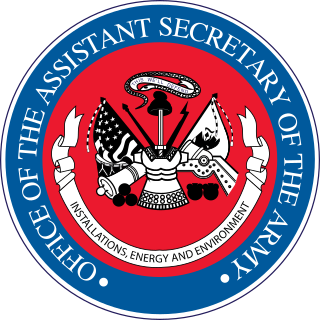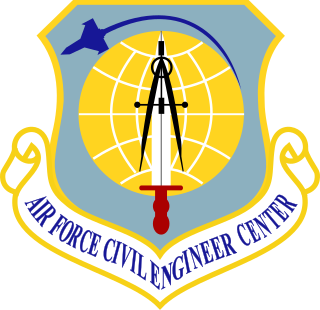
Strategic Air Command (SAC) was a United States Department of Defense Specified Command and a United States Air Force (USAF) Major Command responsible for command and control of the strategic bomber and intercontinental ballistic missile components of the United States military's strategic nuclear forces from 1946 to 1992. SAC was also responsible for the operation of strategic reconnaissance aircraft and airborne command post aircraft as well as most of the USAF's aerial refueling fleet, including aircraft from the Air Force Reserve (AFRES) and Air National Guard (ANG).

The secretary of the Air Force, sometimes referred to as the secretary of the Department of the Air Force, is the head of the Department of the Air Force and the service secretary for the United States Air Force and United States Space Force. The secretary of the Air Force is a civilian appointed by the president, by and with the advice and consent of the Senate. The secretary reports to the secretary of defense and/or the deputy secretary of defense, and is by statute responsible for and has the authority to conduct all the affairs of the Department of the Air Force.

The United States Department of the Air Force (DAF) is one of the three military departments within the Department of Defense of the United States of America. The Department of the Air Force was formed on September 18, 1947, per the National Security Act of 1947 and it is the military department within which the United States Air Force and the United States Space Force are organized.

The Air Staff is one of the Department of the Air Force's two statutorily designated headquarters staffs: the other staff is the Office of the Secretary of the Air Force, also known as the Secretariat. The Air Staff is headed by the Chief of Staff of the Air Force. The Air Staff is primarily composed of uniformed U.S. Air Force officials who assist the Chief of Staff in carrying out his dual-hatted role: as the principal military advisor to the Secretary of the Air Force, and as a member of the Joint Chiefs of Staff.

The Naval Air Warfare Center Training Systems Division (NAWCTSD) is an Echelon IV command of the United States Navy, reporting to the Commander, Naval Air Warfare Center - Aircraft Division (NAWCAD) at NAS Patuxent River, Maryland. NAWCTSD is located in Orlando, Florida in the Central Florida Research Park, adjacent to the University of Central Florida (UCF). The facility is a part of a larger military installation within the Central Florida Research Park known as Naval Support Activity Orlando.
The structure of the United States Air Force refers to the unit designators and organizational hierarchy of the United States Air Force, which starts at the most senior commands.

An aviation biofuel or bio-jet fuel or bio-aviation fuel (BAF) is a biofuel used to power aircraft and is said to be a sustainable aviation fuel (SAF). The International Air Transport Association (IATA) considers it a key element to reducing the carbon footprint within the environmental impact of aviation. Aviation biofuel could help decarbonize medium- and long-haul air travel generating most emissions, and could extend the life of older aircraft types by lowering their carbon footprint.

The Assistant Secretary of the Air Force (SAF/AQ) is a civilian position in the Department of the Air Force that is appointed by the president of the United States and confirmed by the United States Senate. This position is established under Title 10 US Code Section 9016 and is one of five Assistant Secretary positions under the Secretary of the Air Force. The Assistant Secretary reports to the Secretary of the Air Force.

The Oklahoma City Air Logistics Complex (OC-ALC) Tinker Air Force Base, Oklahoma is one of the largest units in the Air Force Materiel Command. The complex performs programmed depot maintenance on the C/KC-135, B-1B, B-52 and E-3 aircraft; expanded phase maintenance on the Navy E-6 aircraft; and maintenance, repair and overhaul of F100, F101, F108, F110, F117, F118, F119, F135, and TF33 engines for the Air Force, Air Force Reserve, Air National Guard, Navy and foreign military sales. Additionally, the complex is responsible for the maintenance, repair and overhaul of a myriad of Air Force and Navy airborne accessory components, and the development and sustainment of a diverse portfolio of operational flight programs, test program sets, automatic test equipment, and industrial automation software.

The Air Force Medical Operations Agency (AFMOA), Port San Antonio, Texas, oversees execution of the Air Force Surgeon General policies supporting Air Force expeditionary capabilities, healthcare operations, and national security strategy. It provides expert consultative leadership support to 75 military treatment facilities and eleven major commands/direct reporting units to ensure cost-effective, modern, and prevention-based healthcare continuum for 2.1 million beneficiaries worldwide. The AFMOA directs and supports the clinical currency of 43,131 healthcare professionals providing 6.6 million visits and 133,500 bed days. The agency provides clinical and population health data and analysis to AF/SG and MAJCOM surgeons. The agency partners with the Assistant Secretary of Defense, Secretary of the Air Force, Chief of Staff of the Air Force, and the Department of Veterans Affairs.

The Assistant Secretary of the Army for Installations, Energy and Environment is a civilian office within the United States Department of the Army.

The Assistant Secretary of Defense for Energy, Installations, and Environment, formerly known as the Deputy Under Secretary of Defense for Installations and Environment, provides management and oversight of military installations worldwide and manages environmental, safety, and occupational health programs for the Department of Defense (DoD). DoD's installations cover some 29,000,000 acres (120,000 km2), with 539,000 buildings and structures valued at more than $700 billion. The responsibilities of the ASD(EI&E) include the development of installation capabilities, programs, and budgets; installation-energy programs and policy; base realignment and closure; privatization of military housing and utilities; and integration of environmental needs into the weapons acquisition process. The ASD(EI&E) is also responsible for environmental management, safety and occupational health; environmental restoration at active and closing bases; conservation of natural and cultural resources; pollution prevention; environmental research and technology; fire protection; and explosives safety. The ASD(EI&E) reports to the Under Secretary of Defense for Acquisition and Sustainment, and is a part of the Office of the Secretary of Defense.

The Assistant Secretary of the Air Force for Financial Management and Comptroller (SAF/FM) is a civilian official in the United States Department of the Air Force.

Assistant Secretary of the Air Force is the title of a civilian office in the United States Department of the Air Force. Along with the four other Assistant Secretaries of the Air Force, the Assistant Secretary of the Air Force assists the United States Secretary of the Air Force and the United States Under Secretary of the Air Force.

The United States Department of Defense is one of the largest single consumers of energy in the world, responsible for 93% of all US government fuel consumption in 2007 (Air Force: 52%; Navy: 33%; Army: 7%. Other DoD: 1%). In FY 2006, the DoD used almost 30,000 gigawatt hours (GWH) of electricity, at a cost of almost $2.2 billion. The DoD's electricity use would supply enough electricity to power more than 2.3 million average American homes. In electricity consumption, if it were a country, the DoD would rank 58th in the world, using slightly less than Denmark and slightly more than Syria (CIA World Factbook, 2006). The Department of Defense uses 4,600,000,000 US gallons (1.7×1010 L) of fuel annually, an average of 12,600,000 US gallons (48,000,000 L) of fuel per day. A large Army division may use about 6,000 US gallons (23,000 L) per day. According to the 2005 CIA World Factbook, if it were a country, the DoD would rank 34th in the world in average daily oil use, coming in just behind Iraq and just ahead of Sweden.

The Air Force Civil Engineer Center (AFCEC), located at Joint Base San Antonio-Lackland, Texas, is a 1,900-person primary subordinate unit, assigned to the Air Force Installation and Mission Support Center which is one of six centers aligned under Air Force Materiel Command for the United States Air Force. The center is responsible for providing responsive, flexible full-spectrum installation engineering services. Conducting operations at more than 75 locations worldwide, the center's missions include facility investment planning, design and construction, operations support, real property management, energy support, environmental compliance and restoration, and audit assertions, acquisition and program management.

The Office of Energy Assurance was established by the United States Secretary of the Air Force and Chief of Staff of the Air Force in February 2016 to serve as a central management office dedicated to strategic energy and resiliency.

The Assistant Secretary of the Air Force for Space Acquisition and Integration is a civilian position in the United States Department of the Air Force that is appointed by the president of the United States and confirmed by the United States Senate. This position is established under Title 10 US Code Section 9016. The assistant secretary reports to the Secretary of the Air Force.

David R. Iverson is a United States Air Force major general who most recently served as the Vice Director for Joint Force Development (J7) on the Joint Staff from July 2019 to July 2021. Supporting Vice Admiral Stuart B. Munsch, then the Director, J7, Iverson provided oversight and direction of a diverse organization that provides for joint training, joint force development, concept development, operational analysis and lesson-learned activities to achieve the chairman's vision for the National Military Strategy. Before this assignment, he served as the Commanding General of the 332nd Air Expeditionary Wing from June 2018 to June 2019.

















